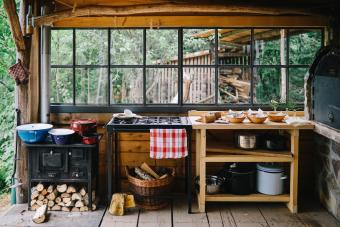
A home design structure of years gone by, the summer kitchen carries an interesting history, and some are still found in historical homes across the United States today. Though the original purposes of the historical summer kitchen design are not relevant for modern day home owners, the idea of an outdoor kitchen is still appealing. Discover what a summer kitchen is and what a modern summer kitchen looks like and decide if this house extension would add value to your own home.
Defining the Summer Kitchen
The summer kitchens established and designed by 18th and 19th century homeowners served a few purposes. In short, a summer kitchen was an additional cooking and food storage building close to the main house. Some summer kitchens existed as extensions or wings of the main house, but most were standalone structures that were detached from the main building. Relatively small and shed-like in appearance, summer kitchens served as the main food prep areas, so the interior of the home was free from any signs of cooking.

Origins of the Summer Kitchen
Designed in the 1700s and popularized in the 1800s, summer kitchens were originally conceptualized to separate risks and sensory details associated with kitchens from the main house. With an outdoor kitchen structure, the risk of fire to the main house was far less probable. The sights, sounds, and smells of the kitchen were also concealed from guests and families during food preparation, as they brought food into the main house once they prepared it in the summer kitchen.
Perhaps the reason for its name, summer kitchens kept the main home from getting too hot in the warmer months as the stove or fireplace was being used to prepare meals. Though they were predominantly food preparation spaces, they also used the summer kitchen for laundering, sewing, and food storage.
Wealthy homeowners were more likely to have summer kitchens, and it wasn't until the structure became a normal part of homes and properties that less wealthy families also came to enjoy these home extensions. Mostly seen in the Midwest and New England areas of the United States, you can still find a few original summer kitchens on historical properties. Most have given way to natural decay over time, though there are many preserved on historical sites and some still found in 18th and 19th century homes on and off the market today.

Characteristics of a True Summer Kitchen
If you're looking at home listings or trying to discover if a building on your own property may have been a summer kitchen, there are a few characteristics that might confirm your guesses.
Since summer kitchens were designed specifically for food preparation, there would be a wood-burning stove or fireplace present in the building. A large workspace for food prep, sewing, and laundry would also be in summer houses. An area for food storage or cleaning produce may have also been present in summer kitchens, so you might notice a small pantry, shelving, or a place for a washbasin.
Most summer kitchens were only one storey, though there were some that had an additional half storey for food storage or sleeping quarters. Structures may or may not have matched the main house in material or colors, and most are constructed with wood, stone, or brick.

Defining Modern Summer Kitchens
Though the original purpose of the 18th and 19th century kitchens no longer impacts homeowners, there are still modern homes with a new variation of the historical design. Just as the original summer kitchen was often a sign of luxury, the modern summer kitchen feels luxurious and regal.
The summer kitchens of today, gaining popularity in modern homes and in remodels, still have the basic cooking principles and necessities at the center. The difference here is that the outdoor kitchen is more of a patio or home extension with a simple overhead covering. You might not see a wood-burning stove or a fireplace, but you are likely to spot a gas grill or even a pizza oven.

You might see a large outdoor dining space or lounging area by the modern summer kitchen. Most outdoor kitchens are right outside of the interior dining room or kitchen for convenience, and you access them through a sliding-glass door or French doors.
Some historical homes across the country may still have the original summer kitchen structures, but most are no longer used for food preparation. Remodeled or restored summer kitchens are most often used as guest houses or storage spaces. If you have this historical structure on your own property, you might transform it into a home office, art studio, library, or rental space.
Combining Historical Structures With Modern Styles
The summer kitchens of centuries past may be rare and lost to the elements and the passing of time. But modern summer kitchens are carrying the history of the design with them in outdoor cooking and dining spaces. For the few summer kitchens still in existence, there's an opportunity to transform a building of the past into a useful space in modern-day design.







